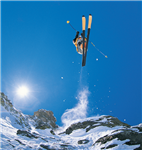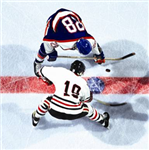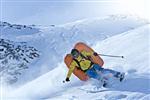Plastics: omnipresent at Sochi
 The 22nd Olympic Winter Games in Sochi would not happen without plastics: in the 92 different disciplines, polymers are omnipresent – and they are often the decisive bit. From alpine skiing to biathlon or toboggan, sport people and equipment have to deliver the best performance. To ensure the best results, the material used must be top quality. Nowadays, no winter sports equipment, no winter clothing nor shoes can do without plastics. This is true for Olympic athletes but also for all those playing sports in their leisure time.
The 22nd Olympic Winter Games in Sochi would not happen without plastics: in the 92 different disciplines, polymers are omnipresent – and they are often the decisive bit. From alpine skiing to biathlon or toboggan, sport people and equipment have to deliver the best performance. To ensure the best results, the material used must be top quality. Nowadays, no winter sports equipment, no winter clothing nor shoes can do without plastics. This is true for Olympic athletes but also for all those playing sports in their leisure time.

Modern alpine skis
are made of different materials and several layers of plastics. That makes them both lightweight, and highly resistant and suitable for snow gliding.
© Celanese

Cross-country skiing and biathlon
In cross-country skiing and biathlon, the bottom surface and the way the skies glide often make the difference. Various types of plastic waxing can make the ideal glide surface for any type of snow and temperature. These glide waxes are simply applied to the bottom surface of the ski.
© Matteo Festi Shutterstock

Luging
as well as bobsleighing is heavily depending on plastics. Speeds up to 150 km/h would hardly be reachable without polymers. Aerodynamics and lightness is key to success. Modern composite materials give strength and stiffness, absorb shocks and withstand extreme temperatures up to minus 30 and below.
Brady Canfield skeleton racer © Shutterstock

Ski jumping
requires courage, timing and perfect aerodynamics. Top jumping teams invest in the development of new materials to improve aerodynamics. At the current winter games, new jumping suits guarantee larger air intake thanks to innovative seams and optimised weft based on synthetic fibres, which help reduce airflows on the back. Modern jumping skis are smooth which results in reducing friction and increasing speed. In Sochi, the in run of the take-off ramp is made of plastics to guarantee equal conditions for all jumpers.
© Shutterstock

Ice hockey
is a full contact sport. Protective equipment is therefore mandatory, including helmet, shoulder, elbow and shin pads, mouth guard, protective gloves and padded shorts. In this case too, plastics meet the requirements! Even hockey sticks, which were once made of wood, are today made of composite materials. Numerous sport clubs in Northern America and Eastern Europe provide artificial training surfaces made of plastics, leaving out the traditional ice.© Celanese
Ski boots
Olympic games fashion quickly makes its way to department stores. The new generation of ski boots is already available for sale. These boots are much lighter and offer better insulation. Plastic inner and outer soles are designed to take the shape of the feet, enabling thereby better comfort and stability.
© Shutterstock

Ski helmets
Today, for good reasons, a large majority of alpine skiers wear a helmet. These helmets which change design every season also increase the skiers’ performance. Nowadays, modern ski and snowboard helmets offer a high level of safety. Over the past years, their shock resistance has significantly improved without increasing their weight.
© Shutterstock
Avalanche airbags
Even though snow slides are the most serious natural hazards, avalanche airbags will significantly reduce the risk of complete burial in the snow. This is why rescue teams in the Alps as well as many free riders use these systems that consist of big plastic cushions that can be blown up with air in a blink of an eye.
© ABS Avalanche Airbag / Hansi Heckmair

Ski clothing
Modern ski clothing (from underwear to pants, shirt, jacket and gloves) is made of synthetic fibres that keep you warm and dry, while making you look cool.
© Celanese

Outdoor furniture
This fashionable and highly resistant outdoor furniture provides a colourful and comfortable "rest area” at 1,840 meter altitude.
© PlasticsEurope
Did you know ?
Baggage made of polycarbonate resin are ultra-light (light enough to be held with your forefinger when the bag is empty) and yet highly durable.
More than 50 per cent of all medicine products worldwide are made of plastics.
The world is spending 16 billion one-way plastics syringes per year.
Plastic whisper brakes in freight trains are only half as loud as conventional brakes.
A large German automobile manufacturer is using recycled PET bottles for seat cushions in some of their car product series.
A new polymer can heal itself when damaged similar to the human skin.
Main countries of Europe will save at least 78.000 tons of plastics per year if the produced pens were made from recycled plastic.
This pen with a water bottle shape is called B2P (From bottle to pen) and is made of 89% of plastic coming from recycled bottles of water.© Pilot
The first bio-based car was build 73 ago with a body made of soybeans/hemp (70%) and resin binder (30%)
The typical life span of plastic applications in building and construction is 30 to 50 years, with many plastics pipes installed over 50 years ago still functioning well
Selling grapes in plastics trays or bags has reduced in-store waste of grapes by 20%.
The plastics Industry launched over 180 projects worldwide for solutions on marine litter.
Researchers at Texas A&M University have developed a spongy plastic that could help regenerate broken bones.
Thanks to plastics bikes went on diet and dropped weight: 20 kg in 1903 -> 6.8 kg in 2014 !
An Indian teacher of chemistry known as Plastic Man has built more than 5000 km of roads with plastic waste.
